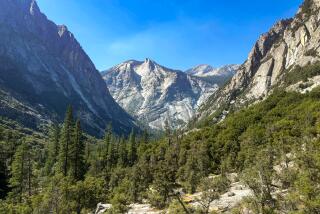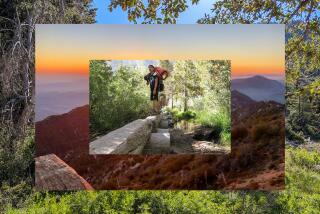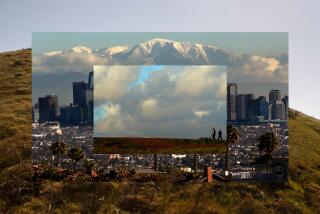Forest Users to Get a Hike
- Share via
As of Monday, visitors will have to dig into their pockets to hike, bike or swim in four Southern California national forests because of a pilot program to raise millions of dollars for improvements.
The three-year program, approved by Congress last year, targets the eroding trails and services in Los Padres, Angeles, Cleveland and San Bernardino national forests. The fees will be $5 a day or $30 for an annual pass.
The Southern California pilot project, the largest of almost 100 similar programs nationwide, is the latest example of a major philosophical change in the way national forests are operated and funded.
Only motorists driving through the forest land and campers will be exempt. Everyone else must purchase what is called a National Forest Adventure Pass.
“The Forest Service has fallen behind trying to maintain our recreation facilities to the standards we want and the public expects,” said Jim Youngson, Los Padres National Forest spokesman. “We’re hoping the public will support it when they see the results of their money.”
Critics who object to ponying up money to walk down a secluded trail or gaze at a stunning mountain vista condemn the pass as little more than another tax or glorified parking fee.
“The forests have belonged to the people of the nation ever since the Forest Service was established, and Congress has funded recreation for that same length of time,” said Alasdair Coyne of the Ojai-based Keep the Sespe Wild Committee. “And now they’ve decided they can’t afford to do so and they’re trying to foist off the costs to the general public.”
But the program, which Congress will review in 1999, is merely the most visible manifestation of an overhaul of Forest Service operations. Increasingly, services are being provided by private businesses.
Until January 1996, only one private company operated a Forest Service site in Los Padres: Wheeler Gorge campground north of Ojai. Today, three companies run 21 campgrounds and 12 day-use areas at seven recreation sites under five-year contracts.
Moreover, a national review is underway to streamline the permit process that covers everything from filming to owning summer cabins in the forests.
An outgrowth of a concept with a telling name--Enterprise Forest--it is an effort to cut costs and bring in more money.
“We are trying to run ourselves like a business,” Youngson said. “To provide quality services you have to charge fair market value. That’s a concept the Forest Service is trying to pick up on.”
It is a philosophy that did not exist at the turn of the century when the local national forests were created to protect the watershed that hundreds of thousands of people now rely on for clean drinking water.
Watershed protection remains the primary function today, with about half of Los Padres’ $14-million annual budget dedicated to preventing fires--and thus protecting water quality--on what is considered among the nation’s most fire-prone forests, officials said.
But the state’s third-biggest forust stretches 220 miles from the Carmel Valley to the fringe of Los Angeles County and is more closely associated with recreation than watershed concerns.
Although about half of Los Padres’ land is designated wilderness, officials consider it an “urban forest” because of the millions of people living within an hour’s drive of its facilities.
In the vernacular of those who have watched popular national parks struggle to accommodate millions of visitors, the forest is being “loved to death.”
On snowy winter weekends, the crush of fun-seeking urbanites has threatened to overwhelm the forest’s capacity to handle them. That occasionally forces the California Highway Patrol to close roads leading into the forest and send tourists back.
And in the summer, officials restrict access to some campgrounds in the mountains beyond Ojai because visitors’ vehicles literally run over endangered species.
Meanwhile, the forest’s budget has shrunk about $10 million since the mid-1980s. Its 1,500 miles of hiking, biking and off-road trails were once maintained every three years but now receive attention just once a decade.
To bridge the gap between escalating use and shrinking budgets, officials use a variety of tactics.
Volunteers maintain trails, wilderness cabins and perform other work, said Jeff Saley, Los Padres’ human resources coordinator.
More significant, officials have turned to private companies to maintain and operate recreation sites.
Forest officials point to the Wheeler Gorge campground north of Ojai as a model.
For years, the remote camp was known as a haven for raucous parties by high school students, gang members and others.
Faced with overwhelming law enforcement and maintenance problems, Forest Service officials tossed up their hands and in 1987 hired a concessionaire to operate the campground.
Ten years later, Wheeler Gorge is regarded as the epitome of public-private cooperation.
Piru-based Pyramid Enterprises has two on-site hosts whose around-the-clock presence deters unruly campers--staffing the Forest Service can’t match.
A decrease in vandalism has prompted further investment in the campground--including an information kiosk, new fire pits and special sites for disabled campers.
The amenities come with a price. Summer camping fees rose $3 this year to $15 a night--higher than the typical Forest Service fees.
Still, officials say they have received no complaints about rising camping costs. On the contrary, they say the well-maintained restrooms and other touches of civilization have earned plaudits from users.
Seeking to duplicate the success, the Forest Service last year allowed concessionaires to assume operational control of six other sites from Big Sur to Piru.
Yet critics contend that the higher fees have made camping unaffordable for many families while private companies make a profit off public facilities.
And private companies cannot solve all the Forest Service’s problems. Some campgrounds are simply too isolated, small or run-down.
Enter the fee pilot program, another method to recoup some of the $900,000 reduction in Los Padres’ recreation budget over the past five years.
At least 80% of the money collected from the $5 daily fee or $30 annual pass will stay in the local forest rather than reverting to the U.S. Treasury.
Even if only one of every three visitors purchases an Adventure Pass, the program will generate an estimated $6 million annually for all four Southern California forests, officials said.
Starting Monday, the pass should hang from a vehicle’s rear-view mirror, not from a hiker’s neck.
People who briefly pull over to the side of a highway running through the forest do not need to buy a pass. Ojai residents and others who can walk into the forest from their homes do not need a pass either. Neither do people who park outside a forest and then walk in.
But every car parked in the forest should have a pass on it. Failure to purchase passes, which are available at Forest Service offices, could bring a fine of as much as $100.
But people are unlikely to get fined at the program’s outset because officials want the public to support the pass system rather than see it as an enforcement tool.
“We’re not out here to bust people on the forest,” Youngson said. “It’s the spirit of the thing we’re asking people to understand.”
More to Read
Sign up for The Wild
We’ll help you find the best places to hike, bike and run, as well as the perfect silent spots for meditation and yoga.
You may occasionally receive promotional content from the Los Angeles Times.






